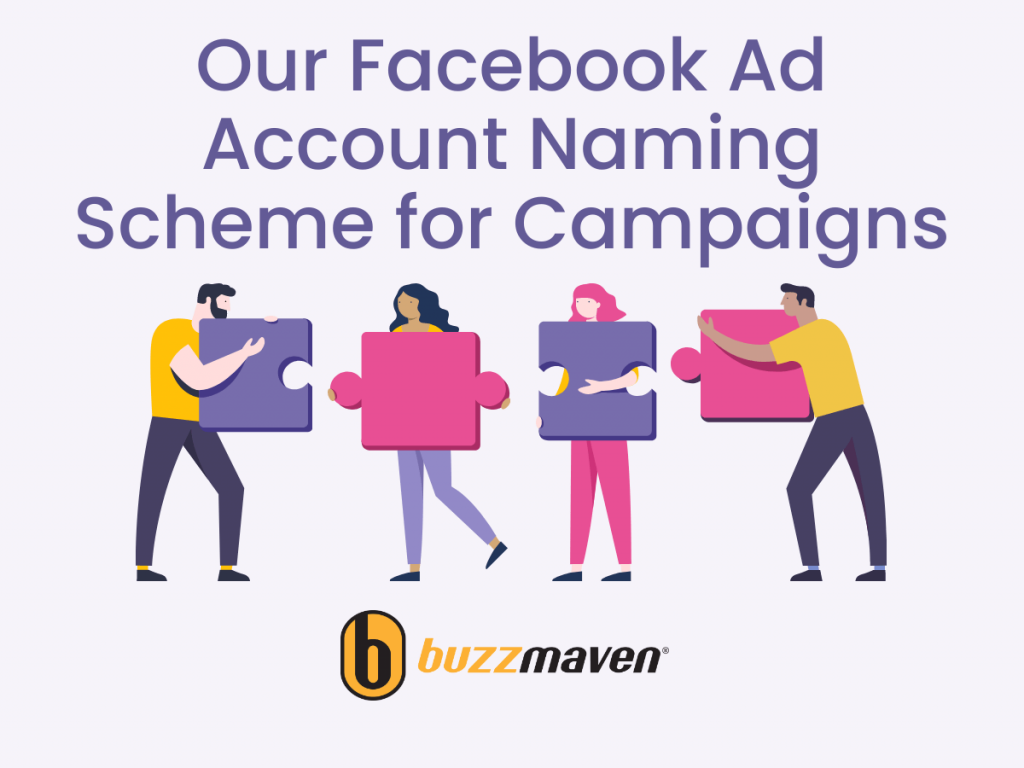
I would like to simply share our naming scheme for Facebook Campaigns and Ads.
We see complete chaos in Facebook accounts more often than not, and much of this confusion could be avoided with a bit of forethought on Facebook ad campaign names. I believe that unless you have your name scheme under control, it’s hard to consider strategy and tactics with a clear mind to improve the account’s performance, especially with a team.
These facebook campaign name conventions are meant to facilitate skimming… informative enough to remember what’s inside without having to open the respective editor every time.
You’ll notice that throughout I omit the use of spaces and encourage the use of “.” and “+” instead. This is because Google Ads and Microsoft Ads do not allow spaces in custom UTM parameters.
Another key part of this naming scheme is that the drill down goes left->to->right so that you can drill down in reporting. Notice how each of these lines could be used to narrow down reporting.
- PS (all Prospecting campaigns)
- PS.Sales (all prospecting campaigns for catalog sales)
- PS.Sales.Ongoing (all ongoing prospecting campaigns for catalog sales)
- PS.Sales.Ongoing.Brand (all ongoing prospecting campaigns for catalog sales for brands)
- PS.Sales.Ongoing.Brand.Acme (all ongoing prospecting campaigns for catalog sales for a brand)
- –>–>–>–>–>–> zooming in
Facebook Campaign Naming Scheme/Convention (revised)
The key to campaign naming is, in addition to the drill down you get for reporting, you are pushing “down” items that are best suited for ad set names. In other words, you are unlikely to refer to gender, language or placements at the campaign level.
Broad Campaign Objective – “PS” , “RT” for Prospecting or Retargeting for example. If your funnel is more than two stages, you can use BOFU,MOFU,TOFU terms here.
Campaign Type (Evergreen, Ongoing or Sale) – Helps sort out short vs longer term campaigns
EXAMPLES:
PS.Sales.Ongoing
RT.Sales.Ongoing
PS.Sales.Ongoing.Category.Shoes
PS.Sales.Ongoing.Brand.Acme
PS.Sales.Sale.All
PS.Sales.Sale.Brand.Acme
PS.Sales.Sale.Category.Shoes
PS.BrandAwareness.Ongoing
TOFU.Leads.Ongoing
MOFU.Leads.Ongoing.Webinar.ABM
BOFU.Leads.Ongoing.Appointments
Facebook Ad Set Naming Scheme
The campaign names above are simple because they push down specifics where appropriate to the ad set.
Naming ad sets varies based on the type of business your in, and whether you’re local, national or international. We have found that adopting a consistent scheme for defining the theme/category of ads within the Facebook adset is wisest.
“Lang-Loc+Sublocation.Gender.Audience+RefinementHints.PlacementType”
- Location+Sublocation – The geographic target of the ad set. EN-US+Subregion is common.
- Gender – The gender target of the ad set, which is important for ecommerce.
- Audience+Refinements– We like to use plain English here but short and sweet to fit on a reasonable report. You may choose to limit the refinement to very high level or this can get messy if you try to fit it all . (e.g. HHI = high houshold income, “Luxury” = luxury audience targeting)
- Placements – We like using AP and MP+Placements reminders here but you may choose to leave this off.
EXAMPLES:
EN-US.Unisex.CartAbandoners.AllPlacements
EN-US.Women.LAL1+Allbuyers.AllPlacements
EN-US.Men.ProductViewers+HHI.AllPlacements
EN-US+KY+Louisville.Women
Facebook Ad Naming Scheme
"Type+Class.FreeFormHint.Version"
- Type-Class reflects the ad presentation and behavior. For example “SingleImage+Dynamic” or “Collection+Static”.
- FreeFormHint– A verbal hint about what’s special about this ad. Very subjective and flexible but the goal is to recall without opening the ad editor. We will sometimes use the Stock image filename here.
- Version – simply V1, V2, V3, etc. reflecting iterations on the ad creative, headlines, etc.
EXAMPLES:
Carousel+Dynamic+Sequence.Man Hiking Autumn.V1
Collection+Static+Provided Hiking Image 1299.V2
SingleVideo+Dynamic.Patagonia Vendor Image 341.V2
Facebook Audience Naming Scheme
"Loc-Region.Gender.Age.FreeformHint"
- Location-Region is similar to above. “EN-US” or “EN-US.MemphisDMA” are examples
- Gender – Men, Women or MultiGender
- Age – 18up, 40up, 30under are typical
- Freeformhint – We use explainers+with+plus+signs between words, just long enough to give the jist.
EXAMPLES:
EN-US.Men.18up.Buyer 1% US Lookalike
EN-US+MemphisDMA.MultiGender.40up.Hiking and Trekking Interests
Let me know what you think! …
How does your naming scheme improve on ours? We’d love to hear from you. We’re sure our ideas reflect the type of clients we work with (ecommerce retail) and may be different for, say, leadgen-heavy campaigns. I generally feel that as long as you are consistent, you’ll do great.
TIP: We put the naming scheme in a google doc and share it with the team and client. This document is not so different from this post – an explainer to help everyone use the same overall campaign language.







